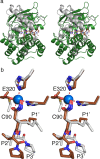Structural basis for the inhibition of M1 family aminopeptidases by the natural product actinonin: Crystal structure in complex with E. coli aminopeptidase N
- PMID: 25644575
- PMCID: PMC4420530
- DOI: 10.1002/pro.2653
Structural basis for the inhibition of M1 family aminopeptidases by the natural product actinonin: Crystal structure in complex with E. coli aminopeptidase N
Abstract
Actinonin is a pseudotripeptide that displays a high affinity towards metalloproteases including peptide deformylases (PDFs) and M1 family aminopeptidases. PDF and M1 family aminopeptidases belong to thermolysin-metzincin superfamily. One of the major differences in terms of substrate binding pockets between these families is presence (in M1 aminopeptidases) or absence (in PDFs) of an S1 substrate pocket. The binding mode of actinonin to PDFs has been established previously; however, it is not clear how the actinonin, without a P1 residue, would bind to the M1 aminopeptidases. Here we describe the crystal structure of Escherichia coli aminopeptidase N (ePepN), a model protein of the M1 family aminopeptidases in complex with actinonin. For comparison we have also determined the structure of ePepN in complex with a well-known tetrapeptide inhibitor, amastatin. From the comparison of the actinonin and amastatin ePepN complexes, it is clear that the P1 residue is not critical as long as strong metal chelating head groups, like hydroxamic acid or α-hydroxy ketone, are present. Results from this study will be useful for the design of selective and efficient hydroxamate inhibitors against M1 family aminopeptidases.
Keywords: M1 aminopeptidase; actinonin; amastatin; matrix metalloproteinase; peptide deformylase.
© 2015 The Protein Society.
Figures





Similar articles
-
The crystal structures of four peptide deformylases bound to the antibiotic actinonin reveal two distinct types: a platform for the structure-based design of antibacterial agents.J Mol Biol. 2002 Jul 26;320(5):951-62. doi: 10.1016/s0022-2836(02)00549-1. J Mol Biol. 2002. PMID: 12126617
-
Hydroxamic acids as potent inhibitors of Fe(II) and Mn(II) E. coli methionine aminopeptidase: biological activities and X-ray structures of oxazole hydroxamate-EcMetAP-Mn complexes.ChemMedChem. 2012 Jun;7(6):1020-30. doi: 10.1002/cmdc.201200076. Epub 2012 Apr 4. ChemMedChem. 2012. PMID: 22489069
-
Antibiotic activity and characterization of BB-3497, a novel peptide deformylase inhibitor.Antimicrob Agents Chemother. 2001 Feb;45(2):563-70. doi: 10.1128/AAC.45.2.563-570.2001. Antimicrob Agents Chemother. 2001. PMID: 11158755 Free PMC article.
-
The complement of family M1 aminopeptidases of Haemonchus contortus--Biotechnological implications.Biotechnol Adv. 2016 Mar-Apr;34(2):65-76. doi: 10.1016/j.biotechadv.2015.10.003. Epub 2015 Oct 24. Biotechnol Adv. 2016. PMID: 26597954 Review.
-
Marine Invertebrates: A Promissory Still Unexplored Source of Inhibitors of Biomedically Relevant Metallo Aminopeptidases Belonging to the M1 and M17 Families.Mar Drugs. 2023 Apr 28;21(5):279. doi: 10.3390/md21050279. Mar Drugs. 2023. PMID: 37233473 Free PMC article. Review.
Cited by
-
Aminopeptidase N: a multifunctional and promising target in medicinal chemistry.RSC Adv. 2025 Jul 23;15(32):26455-26472. doi: 10.1039/d5ra03038b. eCollection 2025 Jul 21. RSC Adv. 2025. PMID: 40703077 Free PMC article. Review.
-
Structure of puromycin-sensitive aminopeptidase and polyglutamine binding.PLoS One. 2023 Jul 13;18(7):e0287086. doi: 10.1371/journal.pone.0287086. eCollection 2023. PLoS One. 2023. PMID: 37440518 Free PMC article.
-
Small molecule inhibition of apicomplexan FtsH1 disrupts plastid biogenesis in human pathogens.Elife. 2017 Aug 18;6:e29865. doi: 10.7554/eLife.29865. Elife. 2017. PMID: 28826494 Free PMC article.
-
Inhibitors of BMP-1/tolloid-like proteinases: efficacy, selectivity and cellular toxicity.FEBS Open Bio. 2018 Nov 12;8(12):2011-2021. doi: 10.1002/2211-5463.12540. eCollection 2018 Dec. FEBS Open Bio. 2018. PMID: 30524951 Free PMC article.
-
Aminobenzosuberone Scaffold as a Modular Chemical Tool for the Inhibition of Therapeutically Relevant M1 Aminopeptidases.Molecules. 2018 Oct 11;23(10):2607. doi: 10.3390/molecules23102607. Molecules. 2018. PMID: 30314342 Free PMC article.
References
-
- Chen DZ, Patel DV, Hackbarth CJ, Wang W, Dreyer G, Young DC, Margolis PS, Wu C, Ni ZJ, Trias J, White RJ, Yuan Z. Actinonin, a naturally occurring antibacterial agent, is a potent deformylase inhibitor. Biochemistry. 2000;39:1256–1262. - PubMed
-
- Butler MS, Blaskovich MA, Cooper MA. Antibiotics in the clinical pipeline in 2013. J Antibiot. 2013;66:571–591. - PubMed
-
- Lee MD, Antczak C, Li Y, Sirotnak FM, Bornmann WG, Scheinberg DA. A new human peptide deformylase inhibitable by actinonin. Biochem Biophys Res Commun. 2003;312:309–315. - PubMed
-
- Xu Y, Lai LT, Gabrilove JL, Scheinberg DA. Antitumor activity of actinonin in vitro and in vivo. Clin Cancer Res. 1998;4:171–176. - PubMed
-
- Bernstein FC, Koetzle TF, Williams GJ, Meyer EF., Jr Brice MD, Rodgers JR, Kennard O, Shimanouchi T, Tasumi M. The Protein Data Bank: a computer-based archival file for macromolecular structures. J Mol Biol. 1977;112:535–542. - PubMed
Publication types
MeSH terms
Substances
LinkOut - more resources
Full Text Sources
Other Literature Sources
Molecular Biology Databases

